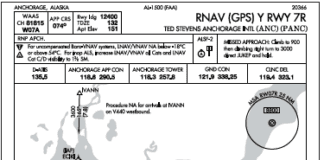How Do You File That?
During a flight originating in Allegheny County, ATC amended our flight plan on a VOR/DME-equipped (no GPS, at least not in the equipment suffix) aircraft: KAGC AGC073 HOMEE JST300 JST SEG…
The change is easy to execute—depart, intercept AGC073 which leads to HOMEE, then fly JST300 to JST—but came a bit as a surprise, because the system would not accept a flight plan that includes intercepting radials (the AGC073 and JST300 components) instead of radial and DME fixes. In talking to FSS their and our assumption was that the AGC073 component was a local ATC operational addition to route us out of busy airspace more precisely.
We were wondering if there is a way (or trick) to include such intercept element when filing a flight plan.
Name withheld by request
Fred Simonds replies:
You are correct. The Route of Flight box accepts only airways and fixes—intersections, VORs and those you create yourself using lat/long or radial/DME. Their information is very specific about this. DUATs does not know how to join a radial at an undefined point because it knows only the fixes. I expect that other filing systems are the same because they all talk to ATC in a standard format.
You can’t fight ‘em so you might as well join ’em. Create a fix to fly to along the airway and define it as, say, the AGC073 radial, say five DME from AGC. Code this in the flight plan as AGC07305.
The AGC 073 radial is part of the KAGC Allegheny 5 Departure which would explain why you were asked to fly that way. The SID shows HOMEE as a transition. You did not receive this SID, but you essentially flew it. This makes the FSS specialist half-right. SIDs make departures more efficient, but this was not a “local ATC operational addition.”
Incidentally, AGC073/JST300 and HOMEE are redundant because those radials define HOMEE. Might be that the computer rejected it knowing this was a duplicate entry or maybe because the entry confused the computer.
CDFA Revisited
I just read your “Mission Statement” in the July Issue of IFR. I can understand the concern expressed by the “highly experienced pilot.” I run into that attitude at our training center from time to time.
We teach a course on CDFA (which I wrote) as a part of our offerings of free courses to our customers. In that program we continuously tell the clients that CDFA (nee CANPA) is a technique, not a procedure, and that a pilot can use it or not.
We also point out the advantages and disadvantages of the technique. The advantages are, as you know, it makes flying a non-precision approach, easier, and it makes the general way we fly all approaches essentially the same, regardless of if it’s an ILS or VOR approach. And of course we stress that a pilot must comply with the step down minimums.
The greatest advantage, as I can see it, is that it allows for a stabilized approach. No changes in pitch, power or configuration. In short, it turns the approach into an old man’s game.
I think the reluctance on the part of some pilots is probably what I call Ancestor Worship—we do it that way because we have always done it that way.
Flying a CDFA does require a little more planning and discipline, but I think if more pilots would try it during VFR, they would find that it can be very helpful particularly on night approaches or in IMC.
George Shanks
Waxahachie, Texas
But It’s Your Butt
“Departures Revisited” by Evan Cushing in September was a great article. However, I think it could have further stressed pilot responsibilities.
For example, a biz-jet departed Brown Field (San Diego) under marginal VFR, hoping to get his clearance in the air. They made contact and received a radar vector heading, passing official terrain separation responsibility to the controller. The pilot didn’t turn, but continued towards rising terrain. The controller said nothing. They crashed, killing all aboard. The lesson here is that it remains the PIC’s ultimate responsibility to have the big picture about terrain.
AIM has some pretty good stuff, if everyone is attentive and playing by the rules. But fatigue and human error are the twin fangs of complacency.
Jim Denike
Newtown, Conn.
Evan Cushing replies:
Good points. I read the accident report with interest. The first thing that struck me was that the flight was VFR when it crashed. Interestingly, the ATC Handbook, Chapter 4-2-8, states that if giving an instruction to a VFR aircraft requesting and awaiting an IFR clearance, the responsibility of terrain and obstruction clearance is transferred to the FAA. Such was the case of the 020 heading (right at the mountains) that was given to the accident aircraft.
The whole business of launching VFR in limited visibility and/or under an overcast hoping to pick up an IFR clearance in the air, is another kettle of fish entirely, and deserves a great deal of scrutiny, especially for higher performance aircraft. The Flight Safety Foundation’s Approach and Landing Accident Reduction Toolkit does a great dissection of the Beechjet accident at KRMG (N25BR) in 1991 and makes an excellent cautionary tale on the subject as well. Of course, the collective human factors issues (end of a long duty day, fatigue, etc.) represent the biggest link in the chain of decisions that seems to have led to this tragedy—reaffirming that Chapter 17 of the Pilot’s Handbook of Aeronautical Knowledge should be known every bit as well as all of the “how airplanes work” chapters.
May I Descend?
When approaching a Class C airport on the clearance, “Fly direct [airport]. Maintain 4000 feet.” When close to the field I get, “Enter left downwind for Runway xx.” Do I still maintain 4000 feet in VMC, planning a visual approach?
Some say I need a clearance to descend, while some say that any clearance to enter the pattern includes the implied clearance to descend to published pattern altitude.
Paul Werbin
Virginia Beach, Va.
Although such a nuance doesn’t have a reference I could find, I’m quite confident you don’t need further altitude clearance. The VFR instruction to enter the pattern implies doing so at pattern altitude—they go hand in hand.
As with any ATC instruction, your trump card is simply to ask, “Do you still need me at 4000 feet?” Now, you’re absolutely certain, with no assumptions.
In similar situations where the intent seems clear but the language might be vague, I always ask for clarification. After all, a few words are a lot safer and easier than a blown instruction.
I know you were looking for a definitive answer, but I don’t have one. For the best answer, visit the tower and ask the controller who issued the instruction.
Well, I Thought It Was Funny
Your November editorial about a ground collision reminded me of when I was a 727 first officer. We had landed at SFO, and as we turned into the gate, a catering truck came around the corner and ran into the left wingtip.
There was just minor damage. It broke the glass over the left wing tip nav-light assembly.
The Captain was a little shaken.
I said, “It could have been worse.”
He said “Yes, it could have been worse.”
I said, “Yes, it could have been on my side.”
He said, “That’s not funny!”
But I thought it was.
George Shanks
Waxahachie, Texas
We read ‘em all and try to answer most e-mail, but it can take a month or more. Please be sure to include your full name and location. Contact us at [email protected].




